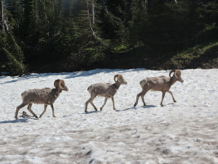Nauru Travel Diary

From Houston to Sydney 2013
From Houston
to Sydney
2013
The famous naturalist John Muir described Glacier National Park as “the best care-killing scenery on the continent”. After having spent our first full day in the park, I would agree wholeheartedly with Muir, and add as well “some of the best mountain and glacial terrains in the western hemisphere”. Add to that some of the cleanest, purest air in North America, and you will begin to understand why Glacier National Park has already impressed us so much.
After all the hectic activity we had undertaken in Houston over the previous two weeks, I didn’t set the alarm this morning, and we eventually awoke at about 8:30 am. Even at that comparatively late hour, the early morning sunshine illuminated the mountains we could see from our room across Saint Mary Lake with a golden hue that made getting out of bed and getting some early photographs a genuine delight.
I managed to squeeze in an early walk before breakfast along the first part of the Otokomi Lake Trail. This trail starts at our motel, the Rising Sun Inn, and climbs 1900 feet over a distance of five miles each way to reach an elevated alpine water body called Otokomi Lake. I only covered the first five hundred metres or so of the track, which took me along the banks of Rose Creek, a beautifully quintessential mountain stream that in various stretches exhibited both laminar and turbulent flow.
After an excellent and leisurely breakfast of whole wheat huckleberry pancakes, we set out to explore the scenery along Going-to-the-Sun Road. This is the main road through the centre of Glacier National Park, and is described as one of the world’s most spectacular highways. It is the same road as we had used to drive to Rising Sun from the Park’s Western Entrance yesterday, but we drove today with a totally different aim; rather than getting to our accommodation, the aim today was appreciating some of America’s finest mountain and glacial landscapes.
Starting from Rising Sun, we drove west, stopping at viewpoints that seemed to command our attention every mile or half-mile. Under almost cloud-free blue skies and clear sunshine, we enjoyed spectacular views of alpine lakes, waterfalls, hanging valleys, cirques, arêtes, canyons, classic glacial U-shaped valleys, streams with tempestuous rapids, scree and talus slopes, snowfields, horns, and of course, steeply-sided snow-capped mountains. Rather than try to describe these wonderful scenes, I will let the photos attached to today’s diary speak for themselves.
Our main activity today was a hike through the snowfields from Logan Pass (which marks the continental divide between the Pacific and Atlantic watersheds of continental North America) and Hidden Lake. Although this walk was only five kilometres round trip, and required a climb of only about 300 feet (up from 6646 feet at Logan Pass), it took us about four hours. There were two reasons for this slow progress. First, the scenery was outrageously picturesque, so I had to keep stopping to get photos. Second, and no less significantly, most of the walk required us to walk across the snowfields that were still burying the boardwalks that will no doubt be exposed as the snow melts in a month or two.
About two-thirds the way to Hidden Lake, the track split into a high track and a low track. I chose the high track, which ascended up across a high mound of unconsolidated glacial moraine, which Di took the lower track across still more snowfields. The high track gave some great views across the surrounding valleys and snowfields, and at one stage a mother mountain goat and her new-born kid climbed up the sides of the moraine and walked along the ridge top with me – a truly magic moment. Descending from the moraine was no more elegant than my ascent, but the experience was truly worth the effort.
After meeting up with Di again at the foot of the moraine, we continued along to the lookout over Hidden Lake – one of nature’s grand vistas. Once again, we were joined by some mountain goats, a chipmunk and some marmots.
I found the descent more arduous than the ascent, mainly because I was wearing old shoes with soles that had been worn so smooth that they functioned as skis rather than shoes. But the reward at the end of the descent was some ice-cold water from the bubbler at the visitors’ centre and watching a family of longhorn sheep amble across the snowfields, through the car park, and off up the mountainside on the other side of the road.
This has been a great start to our travels – wonderful scenery, new experiences, some solid exercise, enjoyable food and of course, excellent company.

Day 2 - Glacier National Park
Sunday
7 July 2013

































